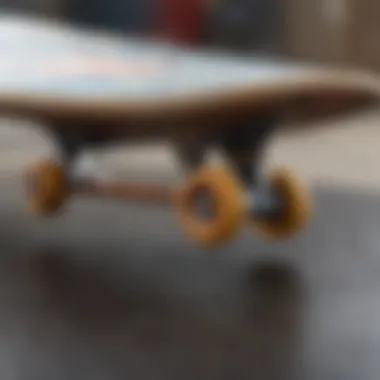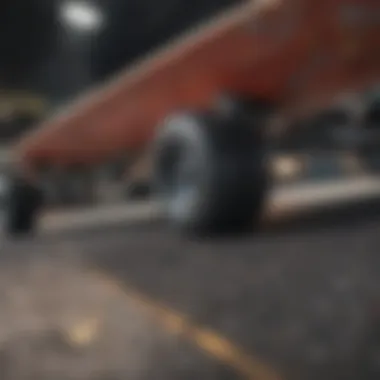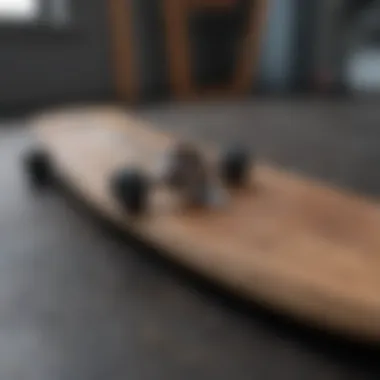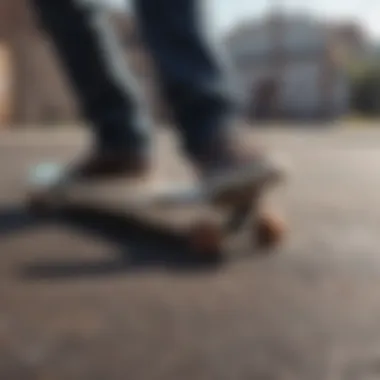Crafting Your Own Skateboard: Design and Build Guide


Intro
Designing and constructing your own skateboard is not just a practice; it's an art form that blends creativity with craftsmanship. This comprehensive guide aims to provide in-depth knowledge about the materials, techniques, and steps involved in crafting a skateboard tailored to individual tastes. It's important for both newcomers and seasoned skateboarders, as personal filters offer insight into the distinct features of skating culture and enhance rider experiences.
The following sections will delve into key aspects like maintaining safety, choosing the right equipment, and highlighting various methods of personalization, which contributes to a broader understanding of skateboarding as an extreme sport.
Understanding the Basics of Skateboarding
Skateboarding serves not just as a sport but also as a form of personal expression and creativity. Knowing the fundamentals is crucial in the customization journey of your skateboard. Understanding the basic aspects informs your choices as you select components that match your personal style and riding preferences. Moreover, a solid grasp of skateboard history and types lays groundwork for better decision-making during the building process. This knowledge enhances your overall skateboarding experience, ensuring you can better connect with the culture and methods involved.
History of Skateboarding
Skateboarding origins can be traced back to the 1950s. It began as a playful variant of surfing on solid ground. An interesting aspect of its history is the role of making skateboards by attaching roller skate wheels to wooden planks. As skateboarding grew, so did its styles and techniques. This evolution reflects broader cultural shifts and the growing subcultures surrounding skateboarding over decades.
By the 1970s, advancements in materials and design boosted performance capabilities. Iconic surfers like Tony Alva contributed to this evolution, while the invention of urethane wheels provided improved grip and control that challenged earlier, more basic designs. Understanding these historical milestones will not only deepen your appreciation but also guide your choices in building a custom setup.
Types of Skateboards
Street Skateboards
Street skateboards represent a category designed explicitly for urban environments. These boards are shorter, which makes them more maneuverable in tight spaces and fit for tricks executed in streets or parks. One significant characteristic is the concave deck, which provides better foot control for controlling tricks. Popular for being versatile, street skateboards often enable skaters to perform ollies, kickflips, and more when navigating obstacles.
However, street skateboards can be less suitable for cruising longer distances because of their shorter wheelbase. Depending on your skateboarding intentions, it’s essential to recognize both the advantages in urban trick applications versus the limitations for longer-distance travel.
Longboards
Longboards are distinguished with their extended deck and greater wheelbase. They are designed mainly for cruising and downhill riding. The key characteristic of longboards is stability at high speeds, amplified by their wider and larger wheels compared to regular street setups. This makes them a beneficial and popular choice for downhill skating or leisurely rides on flat terrains.
A unique feature is the trucks’ design, which allows for smoother turns and carving. However, they may not be ideal for tricks, as the longer deck lacks responsiveness typically necessary for executing street moves.
Skate Cruisers
Skate cruisers blend features from longboards and street skateboards. They are intended for comfortable rides over short distances and increase portability. The copious design choices available enhance their appeal; they often feature softer wheels for better grip and comfort on varied terrains. Cruisers are good for getting around town and casual riding.
Their unique feature is the wheel setup, allowing a smoother ride over cracks and rough surfaces. Although they lack the agility for complex tricks, their stability delivers a satisfying ride for commuter skaters.
Pool and Vert Boards
Pool and vert boards, originally designed for skating in pools and vert ramps, are a specialized option within the skateboard spectrum. Their prominent characteristic is the wide, flat deck contrasted by steep trucks. This structure allows for greater height when performing tricks in vertical settings. The grip is excellent, providing solid footing for aerial moves.
Due to the design emphasis on trick capability, these boards can offer less versatility for regular street use. As an athlete focused on high-air maneuvers and navigating ramps, understanding these aspects will influence your selection based on desired skateboarding environments.
Components of a Custom Skateboard
Crafting a custom skateboard is an engaging project that demands an understanding of various components. Each element plays a crucial role in both its functionality and overall skateboarding experience. When designing a skateboard, be attentive to how these components affect your ride, as this will significantly impact your performance.
Deck
The deck serves as the foundation of your skateboard, impacting stability, control, and comfort while riding. Choices regarding materials and design aspects must be deliberate to suit your skating style and preferences.
Materials Used
Typically, a skateboard deck is made from materials like Canadian maple, bamboo, or fiberglass. Canadian maple is known for its strength and flexibility, making it a popular choice for many riders. Its durability allows it to withstand impact, providing reliable support during tricks and grabs. On contrary, bamboo offers a lighter option but might not resist wear as effectively.
A unique feature about maple decks is their layered construction, which improves the shock absorption. It's essential to realize that using these materials significantly contributes to the overall performance of the skateboard. Light materials promote ease of maneuverability, while heavier choices provide stability in high-speed scenarios.
Shape and Size


The shape and size dimensions of the deck can either enhance or hinder your skating performance. Skateboards come in various widths and lengths, catering to different preferences. A common factor is the width; narrower boards allow for greater trick adaptability, which is a crucial consideration for street skating.
Conversely, larger decks provide more space and stability. This characteristic is particularly beneficial for long-distance rides or beginner skateboarders who need confidence in their stability during maneuvers. Selecting the appropriate deck leads to smoother interpretations across different terrains and enhances your overall riding experience.
Trucks
Truck selection can mediate various performance factors. Good trucks allow seamless transitions and foster intuitive control. Pay attention to both height and width relative to your deck, as mismatches can lead to poor stability and control.
Wheels
Wheel choice demands consideration of both durometer ratings and diameter options.
Durometer Ratings
Durometer ratings essentially describe the hardness of wheels. A rating marked in 'A' degrees is common, and the lower the number, the softer the wheels. Softer wheels (78A to 90A) provide better grip on rough surfaces, a vital quality for street skating. In contrast, harder wheels (above 90A) may cause less friction, facilitating tricks and slides. The benefit of varying hardness lies in adapting your performance to specific skating environments.
Diameter Options
As for diameter options, wheels typically range from 50 to 60 mm in diameter. Smaller wheels are advantageous for street skating, giving riders a lower center of gravity. However, larger wheels excel in providing speed and smooth rides over rough terrain. It's important to balance speed with grip and stability, so matching the wheel size according to your riding style can enhance performance significantly.
Bushings
Bushings play a subtle yet crucial role in how responsive your skateboard is. These small rubber rings affect the turning capability and overall feel of the board. Softer bushings facilitate easy turning and less resistance, which can benefit many riders.
Bearings
Bearings determine how efficiently your wheels spin. High-quality bearings promote better speed and less friction, making your skateboard easy to ride for extended sessions. The ABEC rating indicates the precision of the bearings, with higher ratings compatible with improved speed performance. Paying attention to the detail of choosing the compatible parts ultimately builds a cohesive skateboard that reflects your personal riding style.
Make informed choices on components, as each part contributes to the skateboard’s overall reaction and ride input, satisfying precise riding needs.
Designing Your Custom Skateboard
Designing a custom skateboard is a vital part of the process that allows individuals to express their unique style and preferences. Its importance goes beyond just aesthetics. A well-designed skateboard affects performance and comfort while riding. When making a skateboard, taking into account factors such as color, graphics, and overall theme adds personal value to the board. Furthermore, individuality plays a crucial role in skateboarding culture. Custom designs make it easier for skaters to stand out and convey their personality through what they ride.
Choosing a Theme
Every skateboard begins with an idea. The theme for the skateboard can be as diverse as the rider's personality. When selecting a theme, consider what resonates with you personally. It could be influenced by art, music, culture, or even nature. Selecting a relevant theme not only beautifies the skateboard but can enhance your experience on it.
- Cultural icons: Draw inspiration from artists or movements that inform your style.
- Personal hobbies: Incorporate elements of your interests, such as sports or movies.
- Trends: Consider current style trends, but also strive for a unique twist.
A well-thought-out theme aligns your skateboard's appearance with the emotions or messages you want to express when using it.
Sketching Your Design
Before applying your theme, sketching serves as the essential step towards your final board. Mocking up the design means getting ideas on paper, helping visualize how the colors and shapes will fit together. This part of the process facilitates improvements before committing to paint or graphics.
- Tools Needed: Basic materials like pencils, erasers, and paper set the groundwork.
- Layout: Determine where to place major elements such as graphics and text.
- Experimentation: A sketchpad allows for trial and error, which is crucial. Different placements and sizes can yield surprising results.
By carefully sketching, you create the foundation for your board's artwork, leading to fulfillment in its final production.
Digital Design Tools
Today, design software makes the creative process more efficient. Whether you have advanced skills or are a beginner, several digital tools will enable you to fine-tune your skateboard design.
- Adobe Illustrator: Professional graphic design tool for detailed editing and scalability.
- Canva: User-friendly, web-based platform, ideal for quick designs and integration with other elements.
- SketchUp: Helps visualize the shape and functionality alongside aesthetics.
Leverage these tools to play with designs that are more precise than pencil sketches and adaptable, accommodating instant modifications. Creating digital representations of your skateboards helps in planning your customization journey effectively.


The designs are more than just aesthetics; they embody the person riding it.
Materials and Tools Needed
Crafting a custom skateboard requires a unique set of skills, creativity, and the right supplies. The materials and tools you choose will directly influence the performance and aesthetic of your final product. Understanding what you need is vital to ensure a successful and satisfying build.
Essential Tools
Building your personalized skateboard involves a variety of essential tools. Each tool plays a significant role, allowing for precision and care in assembly. Here is a list of important tools you will need:
- Drill: Essential for creating holes in the deck.
- Screwdriver: Used for fastening parts together such as trucks.
- Wrench: A must-have for securing bolts on trucks and wheels.
- Sandpaper or Sander: Enables smoothing the edges of the deck for safety and aesthetics.
- Utility Knife: Useful for making small cuts on grip tape or design materials.
- Tape Measure: For accurate measurements of components.
Familiarizing yourself with these tools before starting your project will make the process smoother. It is best practice to ensure all tools are functioning properly to avoid setbacks during construction.
Materials Procurement
Acquiring materials for your custom skateboard can be as fun as the assembly itself. The choice of materials affects durability, weight, and overall riding experience. Important materials for your skateboard include:
- Deck: The most vital part, need to choose from wood like maple for strength or bamboo for flexibility.
- Trucks: These support the wheels and play a crucial role in turning; consider aluminum for a mix of strength and light weight.
- Wheels: The selection here influences your ride; for smooth surfaces, choose softer wheels, while for outdoor, aim for rugged options.
When searching for materials, consider the following factors:
- Quality: Invest in high-grade components; they prolong life.
- Compatibility: Ensure different parts fit together correctly.
- Secure Suppliers: Look for the brands actively recommended in skateboarding communities on Reddit or Facebook for reliable materials.
Preparing for a project like this can be exciting if you have your tools and materials organized. A clean work environment enhances your creativity and productivity, allowing a smoother flow of ideas during the build.
Building Your Custom Skateboard
Creating a custom skateboard enables you to tailor every part of it to your personal style and skating needs. This section outlines the key components that go into building a skateboard and explains why each aspect is essential for performance and aesthetics. The process is not just about assembling pieces but also about understanding how each element contributes to the overall experience you will have on the board.
Preparing the Deck
The deck serves as the foundation of your skateboard. It is crucial to select high-quality materials for durability and performance. Most decks are made from layers of maple wood; however, options include bamboo or carbon fiber for different flex characteristics.
You should also determine the shape and size based on your skating style. If you lean toward tricks, a smaller and skinny deck provides more control. Conversely, a wider deck supports stability for large ramps or long rides.
Initial preparation involves sanding the edges and surface of the deck. This step ensures a smooth finish, while also allowing for better grip tape adhesion later. Prioritize a solid workspace to avoid potential issues.
Assembling the Trucks
Trucks are the critical pieces of equipment that provide the support for your skateboard. The importance of the right trucks is clear: they determine how your skateboard turns, balances, and handles. When choosing trucks, match the width to that of your skateboard deck for optimum stability.
Assembly involves bolting the trucks to the deck securely. Align the holes properly to avoid any misbehavior or risks when riding. Use a wrench to tighten the screws, ensuring they are snug but not overly tightened, which could risk damaging the deck.
Installing Wheels and Bearings
Wheels facilitate your movement, while bearings influence how smoothly and quickly you can roll. Standard skateboard wheels are typically made from urethane due to its resilience. The hardness, or durometer rating, and diameter of the wheels should match your skating style. Softer wheels provide grip and stability for cruising, while harder wheels are suited for tricks and ramps.
After choosing the right wheels, you will need to install the bearings. Place lifelong-bearing lubicants to gain efficiency. Install each wheel onto the truck axle, making sure to incorporate spacers, which reduce wear and also contribute to smoother rides.
Final Assembly Steps
Now it’s time for the finishing touches on your custom skateboard. Revisit each component you have installed for stability checks before finalizing assemble. Apply grip tape to the top side of the deck. The texture of the grip tape ensures that you maintain your footing during activities.
Double-check the snug fit of trucks, wheels, and bearings. Properly adjusted devices promote a stress-free riding experience. Lastly, when your deck is decked out with the design and tape, it is ready for testing. The culmination of all steps completes your custom skateboard just right.
Note: Better stability leads to better control.


Testing and Adjustments
Testing and adjustments are critical components in the creation of a custom skateboard. This stage ensures that all elements of the skateboard work harmoniously together, fulfilling both safety and performance standards. No two skateboards are alike, and achieving the right configuration is essential for maximizing rider experience. It is not sufficient to merely construct the skateboard; you must evaluate how each component interacts under real-world conditions. With extensive testing, your skateboard can evolve to fit your specific riding style. Different elements of your setup, from wheel hardness to deck flexibility, can dramatically affect overall performance.
Initial Ride Test
Once you have assembled your custom skateboard, the first action involves conducting an initial ride test. This test serves as a crucial examination of how the skateboard feels during various maneuvers. Subjects should observe stability, responsiveness, and overall comfort throughout the ride. Look for any unusual sounds that may signal the need for further adjustments.
- Ramp Test: Ride on flat surfaces before taking on ramps to analyze speed and handling.
- Turning: Evaluate how well the skateboard maneuvers during sharp turns. A good truck setup will provide a smooth transition.
- Speed Control: Note how easily you can accelerate and bring the skateboard to a stop. This contributes directly to your control and balance.
A structured approach may help in collecting reliable critiques: maintain a ride diary to log preferences, problems, and modifications. The initial ride is not only about discovering shortcomings but also about learning how well the skateboard matches your style.
Making Necessary Adjustments
The feedback from your initial ride test will point toward essential adjustments. Accuracy during this process can significantly refine your skateboard's performance.
- Truck Height Adjustments: Depending on your ramp and flat surface experience, modifying the height can change stability and effectiveness during tricks.
- Wheel Hardness: If the ride felt too hard or too soft, consider exchanging wheels to better suit riding conditions. For instance, reduce softness for a firmer ride that excels in smooth terrains.
- Bearing Quality: Lower-quality bearings may slow down your ride unnecessarily. Ensuring optimal bearing function not only enhances speed but also minimizes wear and tear in long term.
Going through these necessary adjustments ensures that you work toward a balanced setup tailored for your specific needs.
Remember: Continuous testing will lead you closer to an optimal setup. Skateboarding is a dynamic sport that often demands on-the-fly adaptations, so be open to iterating this process as you grow in skill and change riding environment.
Through testing and adjustments, skateboarders prepare for various conditions and elevate the skating experience.
Check resources like Wikipedia and Britannica for additional skateboard and physics references.
Maintenance of Your Custom Skateboard
Maintenance of your skateboard is essential for both performance and longevity. A well-maintained skateboard can improve your riding experience and can extend the lifespan of various components. This process involves regular checks, cleaning, and replacements as needed. Prioritizing maintenance encourages a better connection between you and your board, aligning with your skating style and demands.
Regular Inspections
Regular inspections involve examining all parts of the skateboard. When carried out systematically, these inspections can catch potential problems before they escalate. Check the deck for any signs of cracking or splintering. Any damage here can affect stability while skating.
Inspect the trucks as well. Focus on the bushings and bolts. Look for wear that suggests they may need replacement. When checking the wheels, consider both the durometer and the integrity of bearings. Different riding conditions affect wear, and an intuitive understanding here is vital.
Prioritize checking every part at least once a month or after intense sessions. Documenting any observations may help identify patterns in wear and areas for improvement.
A regular inspection can enhance performance and comfort on your skateboard. Don't overlook this crucial aspect of maintenance.
Cleaning and Upkeep
Cleaning your skateboard serves a practical purpose. Dirt and debris can accumulate on both the deck and the wheels, affecting performance. Use a simple cloth and mild soap to clean the deck, ensuring you dislodge any trapped dirt. Rinse thoroughly, and dry the surface to prevent scratches.
Wheels demand similar attention. Scrub down the edges and inner sections using a brush. Inspect the bearings too; keep these components lubricated to ensure smooth rotation. A little bit of effort in cleaning can significantly influence how your skateboard feels underfoot while riding.
Make maintenance a habit to prolong the life of your custom skateboard and enhance all aspects of your skating enjoyment.
Closure
In the crafting of a custom skateboard, the collective insights provide invaluable benefits, benefiting skaters in distinct ways. This conclusion highlights the essence gained from understanding each intricate aspect of the process.
Recap of the Custom Skateboard Process
The journey from a blank deck to a fully functional skateboard involves several crucial steps: selecting the right components, designing creatively, and methodically assembling everything. Understanding the roles of each component, such as the trucks, wheels, and bearings, helps in creating a board that conforms to one’s preferences. Emphasis on accurate design, thoughtful construction, and attention to maintenance ensures not only a quality ride but also an opportunity for personal expression. The process encourages a deeper bond with the equipment, fostering an understanding of performance and comfort that only comes from customized construction.
Encouragement to Explore Creativity
Crafting a custom skateboard is not merely about practicality; it is a canvas for personal expression. The design freedom allows skaters to infuse their unique personality and style into their boards. Creativity elevates the sport, pushing boundaries and encouraging innovation.
- Try using unusual colors, patterns, or graphics.
- Consider integrating themes that reflect your hobbies or values.
- Don’t hesitate to blend different components that kickflips.] SEGELPAR. detailing the wood grains or paint finishes provides a distinct touch that distinguishes individuals in skate parks.
Every skateboarder has a story. As you craft your skateboard, let your narrative shine through in every detail.
In summary, each choice made during the building process, from material procurement to final assembly, presents an opportunity for displaying creativity. Relishing the crafting experience not only provides a distinct sense of achievement but also enhances pride and dedication to your skateboarding life. Embrace this chance to demonstrate your individuality and stance in the skate community.



